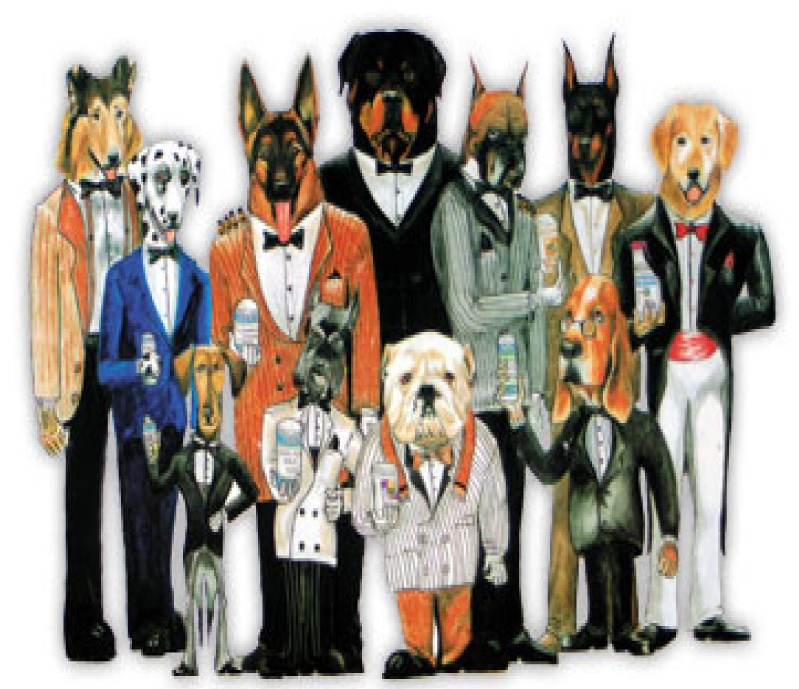Hip Dysplasia
By Dr. Mohamed Mostapha (Egypt)
MVSc Lec. of Vet Surgery, Anesthesiology & Radiology
Dr. Hytham Farghaly, PhD of Vet Surgery, Anesthesiology & Radiology
Usually hip and elbow joints in dogs are commonly affected orthopedically beginning from the growing ages as a juvenile diseases or even in the adult, old ages as an acquired conditions, so genetic selection in breeding and regular vet examination are very necessary to avoid or even minimize the risk of affection of all bones and joints specially both hip and elbow joints.
Hip Dysplasia
Canine hip dysplasia is a genetically inherited musculoskeletal disorder. In non-affected dogs, the hip joint fits together snugly and smoothly. In dogs with hip dysplasia, however, the head of the femur fits loosely into the pelvis, causing excessive rubbing. Eventually, the cartilage that cushions the joint is worn through because of this misalignment, and the dog experiences pain and associated lameness. Severe cases of hip dysplasia can lead to complete loss of mobility in the hind legs.
Diagnosis
The first symptoms of canine hip dysplasia appear during a puppy’s rapid growth, typically between four and nine months old. While there may be no initial clinical symptoms, the dog will eventually begin limping, have a weaving, wavering gait, or may have difficulty running, jumping, or rising from a sitting or sedentary position.
A vet will diagnose hip dysplasia through external examinations (feeling for looseness in the hips) as well as x-rays or radiographs to determine the severity of the joint degeneration. Mild hip dysplasia is similar to osteoarthritis in humans and dogs can easily learn to live with the condition and enjoy full, happy lives.
Treatment
While hip dysplasia is not actually curable, it is definitely treatable. In fact, there are a number of forms of treatment that can help to greatly reduce the pain, discomfort, and immobility caused by this degenerative joint disease. The form of treatment necessary for your individual pet will depend upon the severity of the condition. Some methods include arthritis medications, surgery, and carefully monitored weight loss.
There are also several natural and homeopathic remedies that can greatly improve your dog’s comfort, quality of life and health of joints, thereby greatly increasing comfort. A number of different secondary nutrients can also be beneficial, by helping chondroitin and glucosamine to perform their healing functions while also promoting health and alleviating pain. Some such secondary nutrients include vitamin C, vitamin E, zinc, and manganese. By offering a combination of these nutrients, homeopathic remedies can provide your dog with significant relief from the uncomfortable and debilitating symptoms of canine hip dysplasia. No matter what type of treatment you undertake for your dog, however, be sure that it is done under the supervision of a veterinarian in order to ensure the best quality care and results for your beloved canine companion.
Suggested Products
Canhydrox gag is a German product of Canina Company and is considered number one in the Egyptian vet market due to real positive results.
Surgery for canine hip dysplasia
While every attempt is normally made to manage a pet’s pain through lifestyle adjustments and use of anti-inflammatories and painkillers, surgical intervention may sometimes be necessary. This is particularly true for older dogs. Different surgical techniques are used in hip dysplasia correction.
Dr. Mohamed Mostapha
- MVSc Lec. of Vet Surgery, Anesthesiology & Radiology
- Diplomated in Vet Surgery, Anesthesiology & Radiology (2003)
- Master graduated in Orthopedic Surgery (2009)
- General manager to Alpha Vet Polyclinic Center in Egypt
- Senior manager in an Egyptian governmental hospital

